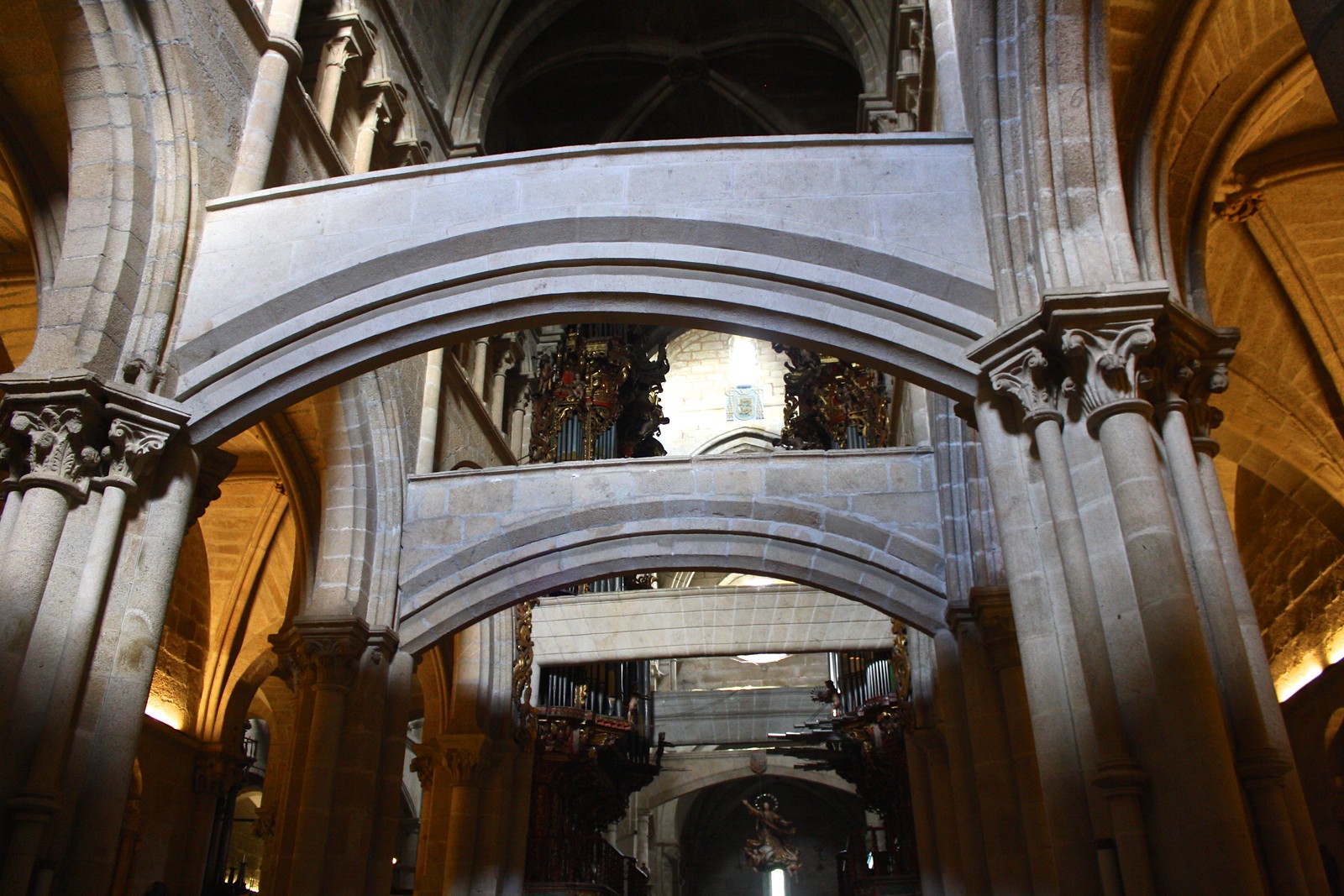As a major architecture nerd, there’s nothing I love exploring while traveling so much as a sprawling castle, a light-filled church, or a stately mansion. I really enjoy getting to see in person how western architectural styles evolved over the centuries, from the most primitive of
pre-Romanesque to the fascinating contemporary stuff built today. And while I may not be a Roman Catholic, I nevertheless did grow up in the church, so cathedrals hold a special place in my heart.
Over the past two years it’s been exciting to check out all five cathedrals located in Galicia, Spain’s northwestern region, from
Santiago de Compostela’s monumental masterpiece to the humble mountain sanctuary of Mondoñedo. Let me share with you the interesting churches that head up the five Galician dioceses.
1) Lugo
Like all the rest of the cathedrals in Galicia,
Lugo’s is at its core a Romanesque church, characterized by thick, heavy walls and columns with narrow slits for windows and lots of sculpture. But there’s quite a bit of Gothic going on here, too, especially in the apse behind the high altar and in the bell tower.
I’ll admit that Lugo’s cathedral is probably my least favorite in Galicia, and its uninspiring Neoclassical main façade seems pasted on to the rest of the church. Every time I go on a stroll at night on top of the city’s still-standing Roman walls, however, I find the cathedral all lit up…and I almost change my mind.
2) Mondoñedo
Nestled in a foggy mountain valley between Lugo capital and the
rugged northern coast, the sleepy village of
Mondoñedo surrounds its small but storied cathedral. Built in the 1200s in the Romanesque style, it later received a stunning Gothic stained-glass rose window and finally two pretty Baroque towers on its west façade.
During restoration work, they discovered some long-lost Gothic
paintings that depict the
Massacre of the Innocents (when King Herod ordered all babies in Judea killed to catch the infant Jesus). The cathedral’s caretaker explained these paintings’ double meaning: Catholic Spaniards were spared from attack by praying to God, whereas Moors were attacked for being Muslims. The painting was, in effect, a polemic during the final days of the Reconquista to get the Muslims to convert.
This diocese’s bishop actually splits his time between the cathedral here in lonely Mondoñedo and out west in Ferrol on the more populated coast. There, the Co-cathedral of San Xiao is unique in that the building was laid out in a Greek cross plan, meaning the “arms” of the church are all of the same length, like this: + whereas a Latin cross † has a long central nave, ideal for processions. This co-cathedral has a serene, neoclassical interior and I love the contrast of the whitewashed exterior with the natural granite.
3) Ourense
Ourense’s cathedral is one of my favorite in the whole country because you can really make out how the Romanesque style, with its heavy walls and taste for semicircular arches, was already in the 1100s converging toward the light, pointy arches and stained glass we all know and love in Gothic-style churches. Although firmly in the Romanesque camp, this cathedral excellently shows off the transition between the two styles.
Two wonders are housed within this cathedral’s walls: the
Chapel of Santo Cristo, a dazzling Baroque cavern almost completely covered in glimmering gold leaf, and the
Pórtico do Paraíso, a collection of Romanesque religious sculpture that, unlike the similar Pórtico da Gloria in Santiago, still preserves its original, colorful paint job.
4) Santiago de Compostela
I could go on and on about Santiago’s cathedral—
and in fact, I have! But for this blog post, suffice it to say that this is one of the Christian world’s most significant cathedrals, as it claims to hold the relics of the Apostle James the Greater, one of Jesus’ closest companions, and as such the cathedral marks the end of the
Camino de Santiago, a medieval pilgrimage route across northern Spain that has seen a rebirth in recent decades.
Over 800 years of history have left their mark on what was originally a clean, granite Romanesque shrine laid out in the pilgrimage church plan, that is, with an aisle running all the way around to let pilgrims wander about without disturbing religious services. And the Pórtico da Gloria, just inside the main west doors, is a true gem of medieval sculpture. But in the Baroque era, exuberant, climbing bell towers sprung up everywhere while gilded side-chapels budded off on all sides. Come as a pilgrim, stay for the architecture, leave hungry for…octopus!
5) Tui
The Galician cathedral that surprised me the most was
Tui’s, just across the border from Portugal. Crowning this historic village’s riverside hill with towers and battlements, Tui’s cathedral appears more castle than anything else—and centuries ago it would have served as a fortress between Castilla and Portugal on the other side of the Miño River.
Cross the threshold beneath the entrance of saints floating into heaven and you’ll immediately be struck by all the crossbeams buttressing the cathedral from collapse. They were installed centuries after the initial Romanesque construction and to this day have protected this historical monument. Step outside into the cloisters and climb up the watchtower and you’ll get some lovely views of the Miño River and the fortress town of
Valença in Portugal.
As with Ferrol in the diocese of Mondoñedo, there’s also a co-cathedral in
Vigo; after all, it’s the biggest city in the region. Merely a small church that evokes a Roman temple, it stands out in Vigo’s tiny old town, visible from the port.
Which is your favorite Galician cathedral? Cast your vote below in the discussion thread!










